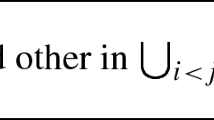Abstract
The notion of an I/O interface for optical digital (write-once) disks is introduced that is quite different from earlier research in this area. The purpose of an I/O interface is to allow existing operating systems and application programs that use magnetic disks to use optical disks instead, with minimum difficulty. The interface is especially geared to applications that are not update-intensive or that require access to previous versions of records. We define what it means for an I/O interface to be disk-efficient. We demonstrate a disk-efficient interface and show that its I/O performance in many cases is optimum, up to a constant factor, among all disk-efficient interfaces. The basis of the interface is a data structure we call offset trees, which stores information about intervals with dynamically changing coordinates. Since this complexity model is based on practical concerns, these theoretical results translate nicely into an efficient implementation.
Some of this research was done while the author was consulting for the IBM Palo Alto Scientific Center. Support was also provided in part by NSF Grant MCS-81-05324, by an IBM research contract, and by ONR and DARPA under Contract N00014-83-K-0146 and ARPA Order No. 4786.
Preview
Unable to display preview. Download preview PDF.
Similar content being viewed by others
References
G. M. Adel'son-Vel'skii and E. M. Landis. An Algorithm for the Organization of Information. An English translation appears in Soviet Mathematics, 3, 5 (July 1962), 1259–1263.
A. V. Aho, J. E. Hopcroft, and J. D. Ullman. The Design and Analysis of Computer Algorithms, Addison-Wesley, Reading, MA (1974).
R. F. Arnold, G. R. Hogsett, R. W. Holliday, and P. J. Friedl. STAR, A Data Base System Architecture—Concepts and Facilities. Technical Report ZZ20-6452, IBM Palo Alto Scientific Center (February 1981).
G. Copeland. What if Mass Storage Were Free? Computer, 15, 7 (July 1982), 27–35.
M. J. Fischer and R. E. Ladner. Data Structures for Efficient Implementation of Sticky Pointers in Text Editors, Technical Report 79-06-08, University of Washington (June 1979).
C. M. Goldstein. Optical Disk Technology and Information. Science, 215, 4534 (Feb. 1982), 862–868.
L. J. Guibas and R. Sedgewick. A Dichromatic Framework for Balanced Trees. Proc. 19th Annual IEEE Symposium on Foundations of Computer Science, Ann Arbor, MI (October 1978), 8–20.
D. Maier. Using Write-Once Memory for Database Storage. Proc. 1st Annual ACM Symposium on Principles of Database Systems, Los Angeles, CA (March 1982), 239–246.
B. T. O'Lear and J. H. Choy. Software Considerations in Mass Storage Systems. Computer, 15, 7 (July 1982), 36–44.
P. Rathmann. Dynamic Data Structures on Optical Disks. Proc. IEEE Computer Data Engineering Conference, Los Angeles, CA (April 1984).
R. L. Rivest and A. Shamir. How to Reuse a “Write-Once” Memory. Proc. 14th Annual ACM Symposium on Theory of Computing, San Francisco, CA (May 1982), 105–113.
D. D. Sleator and R. E. Tarjan. Self-Adjusting Binary Search Trees. A summary appears in Proc. 15th Annual ACM Symposium on Theory of Computing, Boston, MA (April 1983), 235–245.
J. S. Vitter. Search Mechanisms for Optical Disks. Internal Memo, IBM Palo Alto Scientific Center (March 1983).
J. S. Vitter. US&R: A New Framework for Redoing. Proc. ACM Symposium on Practical Software Development Environments, Pittsburgh, PA (April 1984).
Author information
Authors and Affiliations
Editor information
Rights and permissions
Copyright information
© 1984 Springer-Verlag Berlin Heidelberg
About this paper
Cite this paper
Vitter, J.S. (1984). Computational complexity of an optical disk interface. In: Paredaens, J. (eds) Automata, Languages and Programming. ICALP 1984. Lecture Notes in Computer Science, vol 172. Springer, Berlin, Heidelberg. https://doi.org/10.1007/3-540-13345-3_46
Download citation
DOI: https://doi.org/10.1007/3-540-13345-3_46
Published:
Publisher Name: Springer, Berlin, Heidelberg
Print ISBN: 978-3-540-13345-2
Online ISBN: 978-3-540-38886-9
eBook Packages: Springer Book Archive




